Overview
This article dives into how small businesses can really get a handle on passive loss limitations to fine-tune their tax strategies. Understanding Passive Activity Loss (PAL) is key for small business owners. Why? Because it directly impacts how they can offset losses against other income. There are specific eligibility criteria and exceptions that can shake up tax outcomes significantly.
So, let's break it down! Imagine you're a small business owner, and you find yourself facing some losses. Knowing how PAL works can help you navigate those tricky waters. It’s all about making sure you’re aware of the rules that could work in your favor. Plus, who doesn’t love a good tax strategy that can save money?
In short, grasping the ins and outs of PAL isn’t just important; it’s essential for optimizing your tax situation. So, keep this in mind as you plan your strategy—understanding these concepts can lead to better financial decisions down the road!
Introduction
Navigating the complexities of Passive Activity Loss (PAL) can feel like a maze for small business owners, right? But getting a grip on this aspect of tax strategy is super important for your financial success. Understanding how PAL affects your ability to offset losses against other income can really unlock some fantastic tax benefits, helping your business thrive even when times get tough.
Now, here’s the kicker: with income limitations and eligibility criteria that seem to change on a whim, how can you effectively use these rules to your advantage while steering clear of potential pitfalls? Let’s dive into this together!
Define Passive Activity Loss and Its Importance for Small Businesses
Passive Activity Loss (PAL) is all about those pesky deficits that pop up from activities where the owner isn’t really involved—think certain investments or rental properties. For small business owners, getting a grip on PAL is super important since it can directly affect how you offset those deficits against your other earnings. The IRS labels passive activities as those where you don’t have significant involvement, and this can really shape your tax strategies and overall financial well-being.
For instance, if your modified adjusted gross income (MAGI) is below $100,000, you might be able to deduct up to $25,000 in rental losses from your other earnings. But watch out! This deduction starts to phase out as your MAGI climbs, disappearing completely once you hit $150,000. Knowing these limits can help you navigate your tax responsibilities more smoothly and boost your financial results.
Take Jane, for example. She runs a veterinary clinic and a rental business. By choosing a grouping election, she can offset losses from her rental property against the profits from her clinic. This strategy helps her lower her overall tax bill. Plus, it’s key to remember that self-rental income counts as active income, meaning it can’t offset losses from passive activities unless you make that grouping election.
By understanding PAL, small business owners can make savvy decisions that not only enhance their tax efficiency but also support long-term growth. So, how are you planning to tackle your own PAL situation?
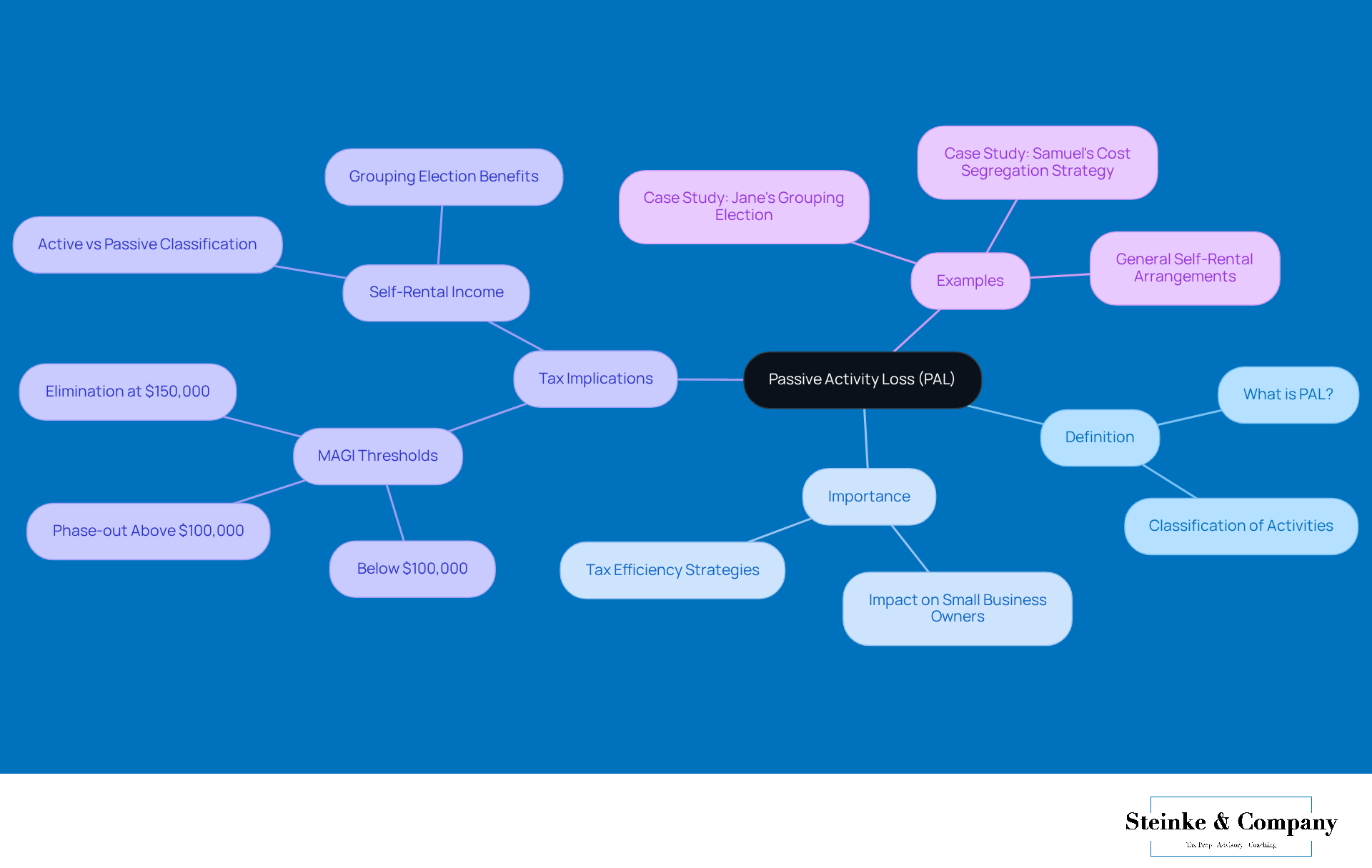
Identify Eligibility Criteria for Passive Loss Participation
If you’re a small business owner looking to qualify for deductions related to inactivity, there are some specific eligibility criteria set by the IRS that you’ll want to keep in mind. Let’s break it down:
-
Material Participation: First up, you need to show that you materially participate in your business activity. This can be determined through various tests. For instance, if you participate for more than 500 hours in a year or are as active as other participants in your venture, you’re in good shape! If you meet any one of the IRS's seven material participation tests, you can deduct the total amount of expenses on your tax returns.
-
Type of Activity: Next, the activity must be classified as non-active. This usually includes rental activities or businesses where you’re not regularly engaged. For example, if you own rental property but don’t oversee it personally, you might qualify for non-active activity deduction treatment. Understanding the ins and outs of rental earnings, including self-employment taxes and potential deductions, is crucial for maximizing your tax advantages.
-
Income Limitations: Now, let’s talk about income thresholds, which can really impact your ability to deduct non-operating deficits. If your modified adjusted gross income (MAGI) exceeds $100,000, the deduction limit for non-active income starts to drop, and it completely vanishes at a MAGI above $150,000. Plus, if you actively participate, you can subtract up to $25,000 of deficit from rental activity, but this allowance gets reduced if your MAGI is over $100,000.
By understanding these criteria and keeping accurate financial documentation—think paystubs and tax records—you can effectively navigate your eligibility for passive loss limitations and plan your tax strategies wisely. Keeping thorough records not only helps with compliance but also ensures that you don’t miss out on potential deductions, which is key to your financial stability.
Also, getting a grip on your paystub details can shed light on earnings and deductions that might affect your tax planning. And don’t forget to consider strategies for maximizing your rental revenue! Enhancing your property’s appeal and understanding the tax responsibilities tied to rental activities can make a big difference.
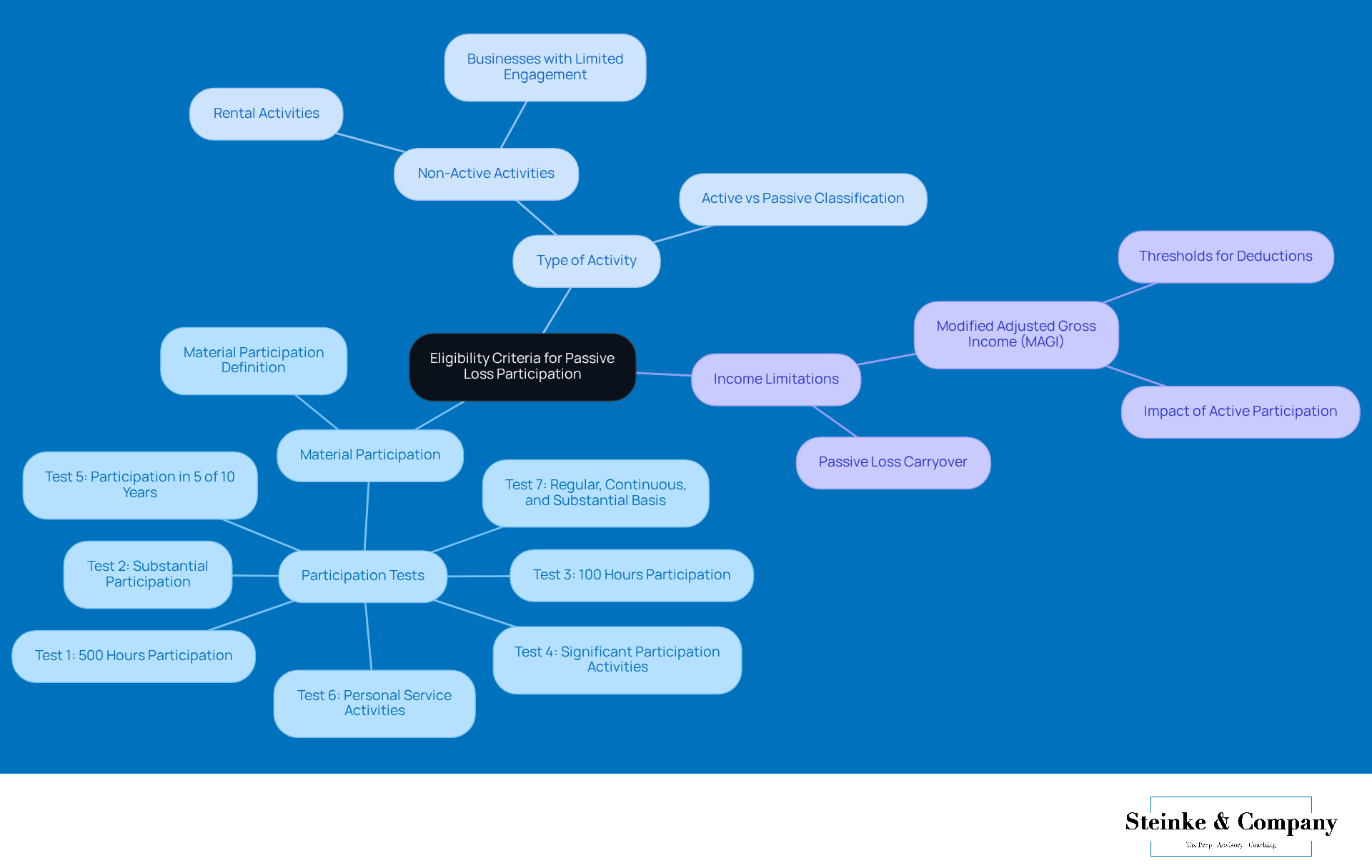
Calculate Passive Activity Loss: Step-by-Step Guide
Calculating Passive Activity Loss can be a bit of a journey, but don’t worry! Let’s break it down into some easy steps:
-
Determine Total Earnings: Start by figuring out how much you earn from all your sources—think wages, business profits, and investment returns. For reference, the average small business owner in the U.S. pulls in about $73,000. This can help you gauge where you stand.
-
Identify Inactive Activities: Next, jot down all the activities you’re not actively involved in, like rental properties or businesses where you’re not really hands-on. Remember, any losses from these activities are considered inactive deficits.
-
Determine Deficits: For each of those inactive activities, calculate the total losses you’ve had during the tax year. This includes expenses, depreciation, and any allowable deductions. For instance, if you have a rental property that brought in $30,000 but cost you $50,000 to maintain, you’d report a $20,000 deficit.
-
Total Deficits: Now, add up all those deficits from your inactive activities to find your overall inactive activity deficit. If this total is greater than your inactive earnings, you can only offset your deficits by the amount of your inactive earnings.
-
Apply Limitations: Any leftover deductions can be carried over to the next tax year. So, if you have a non-active activity deficit of $26,000 but only $15,000 in non-active earnings, you can offset that $15,000 and carry forward the remaining $11,000.
By following these steps, small business owners can accurately assess their inactive activity losses and understand how passive loss limitations affect their overall tax bill. It’s a key part of smart tax planning and making the most of your deductions!
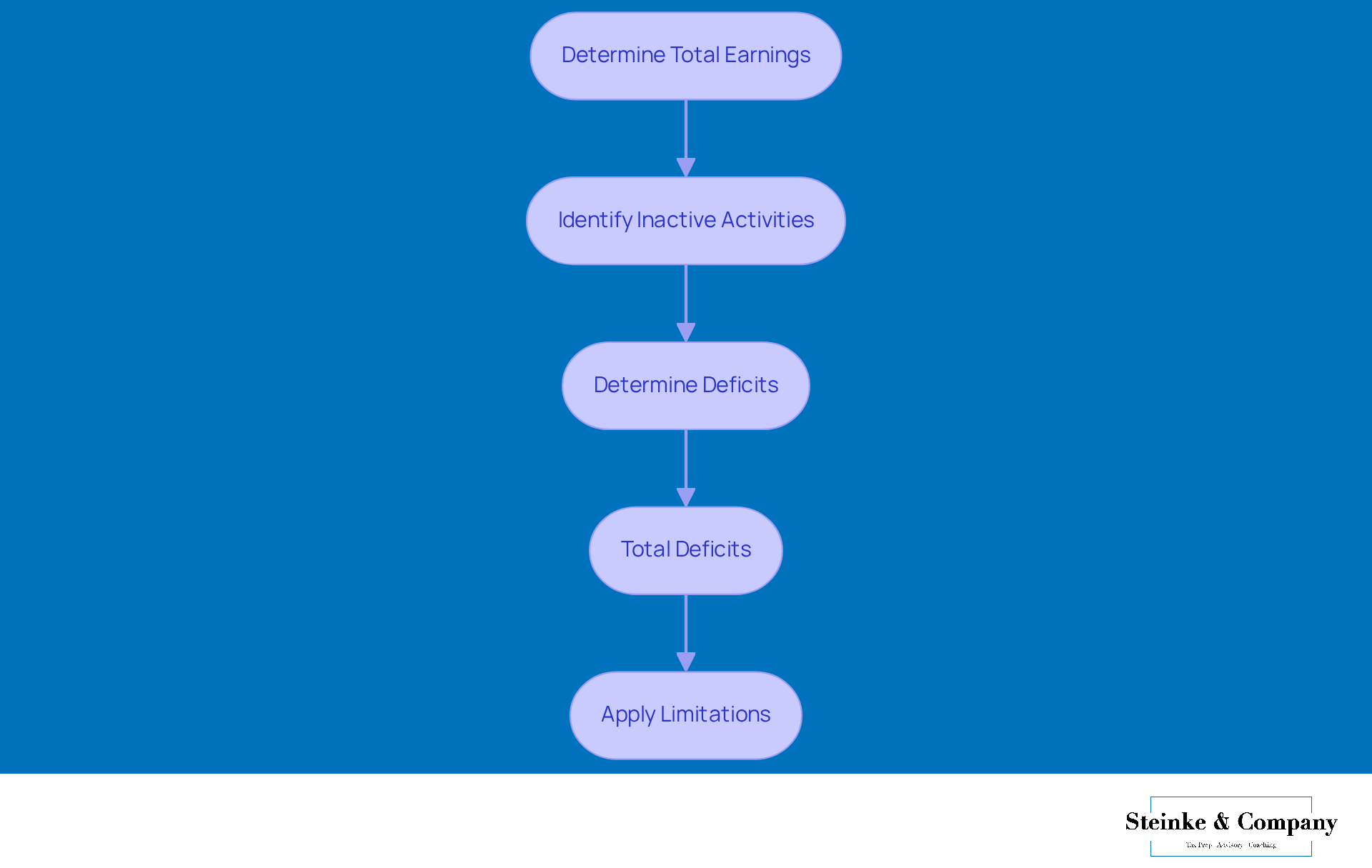
Explore Passive Activity Loss Limitations and Their Implications
Passive loss limitations can significantly influence the tax strategies for small business owners. Let’s break down some key points:
-
Counteracting Non-Active Earnings: Did you know that non-active deductions are only allowed to offset non-active earnings? If you don’t have any unearned revenue in a given tax year, you can’t use those unearned expenses for deductions. For instance, if you own a rental property and bring in $10,000 in rental income but have $11,000 in expenses, you’re looking at a $1,000 non-active loss that can’t be deducted from your active earnings. This is particularly important for Airbnb hosts, who also need to deal with the tricky self-employment taxes on their rental income.
-
Carryforward Guidelines: Here’s a silver lining: when your non-active losses exceed your non-active earnings, you can carry that excess over to future tax years. This means you might be able to use those losses against future unearned income, giving your tax strategy a nice boost. For example, if you face a non-operating loss of $5,000 this year, you can carry that forward to offset any non-operating income in the years to come.
-
Material Participation Tests: If you dive into an activity that you previously didn’t engage in much, you might be able to deduct expenses that were previously disallowed. The IRS has laid out seven tests for material participation, including working over 500 hours in a year, which could really change the tax game for small business owners.
It is crucial for small business owners to understand passive loss limitations. It helps you craft effective tax strategies and avoid any unexpected tax bills. By taking advantage of carryforward rules and grasping the impact of material participation, you can optimize your tax position and improve your financial situation. Plus, with the recent cuts to COVID-19 tax benefits, it’s more important than ever to reassess your tax strategies to stay compliant and dodge any surprises. And don’t forget about underpayment penalties; make sure you meet those safe harbor requirements to avoid any penalties for underestimating your taxes!
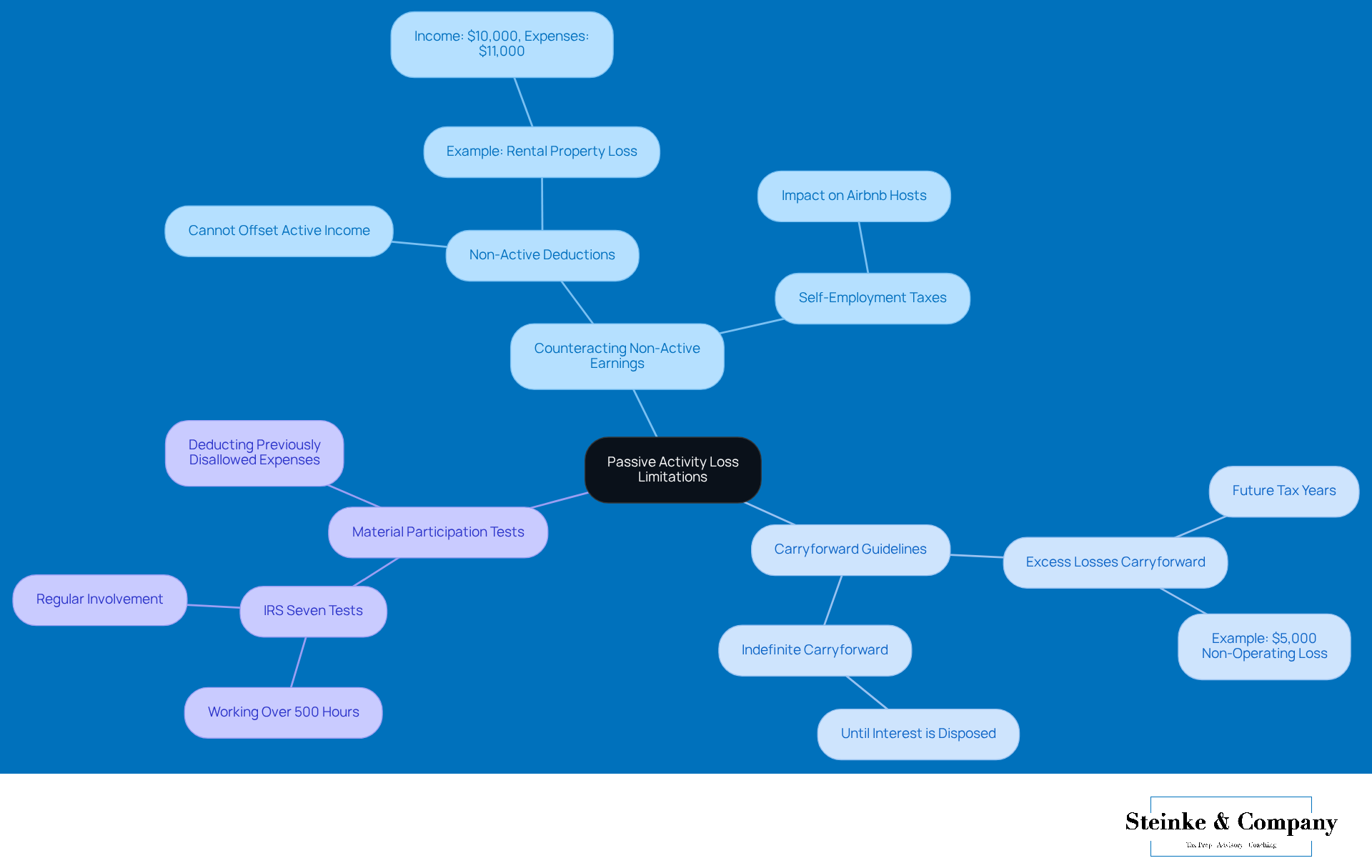
Examine Exceptions to Passive Activity Loss Rules
Hey there, small business owners! It's super important to know about a few exceptions to the passive activity loss rules that could really change your tax game:
-
Real Estate Experts: If you’re recognized as a real estate expert, guess what? You can subtract rental property losses from your other income, like W-2, business, and investment earnings, without any limits—provided you meet certain material participation criteria. This means you can treat those rental losses as non-passive, which can lead to some serious tax savings! Take Joe, for instance; he’s a dentist who managed to slash his federal tax bill from $174,000 down to just $43,000 after picking up two short-term rental properties. Pretty impressive, right? But here’s a heads-up: if you have a full-time job that requires 2,000 hours a year, you won’t qualify for that real estate professional status.
-
Active Involvement in Rental Activities: If you’re actively involved in managing your rental properties, you can deduct up to $25,000 of non-working losses from your non-working income. However, this deduction starts to phase out because of passive loss limitations if your modified adjusted gross earnings exceed $100,000. This is a fantastic opportunity for small landlords who are hands-on with their properties. Just remember, if your modified adjusted gross income is below $100,000, you can claim those rental real estate losses up to $25,000.
-
Some specific closely held corporations can actually avoid those pesky passive loss limitations, giving you even more options for tax relief.
By understanding these exceptions, you can navigate your tax obligations more effectively and potentially maximize those deductions. For example, Rachael and Ross had over $315,000 in rental losses and managed to cut their tax bill by over $62,000 by leveraging their real estate professional status. With some strategic planning, accurate record-keeping, and compliance with IRS regulations, you can really boost your financial outcomes. Just a quick tip: keep realistic time logs to support your REPS claims during any IRS scrutiny, as incorrect claims could lead to audits and penalties. Plus, a spouse can qualify for REPS if they put in 750 hours and spend more time in real estate than in any other job, which can be a game-changer for couples in the real estate biz. And don’t forget, the IRS’s Audit Technique Guide points out signs that might suggest you didn’t materially participate in rental activities, so thorough documentation is key!
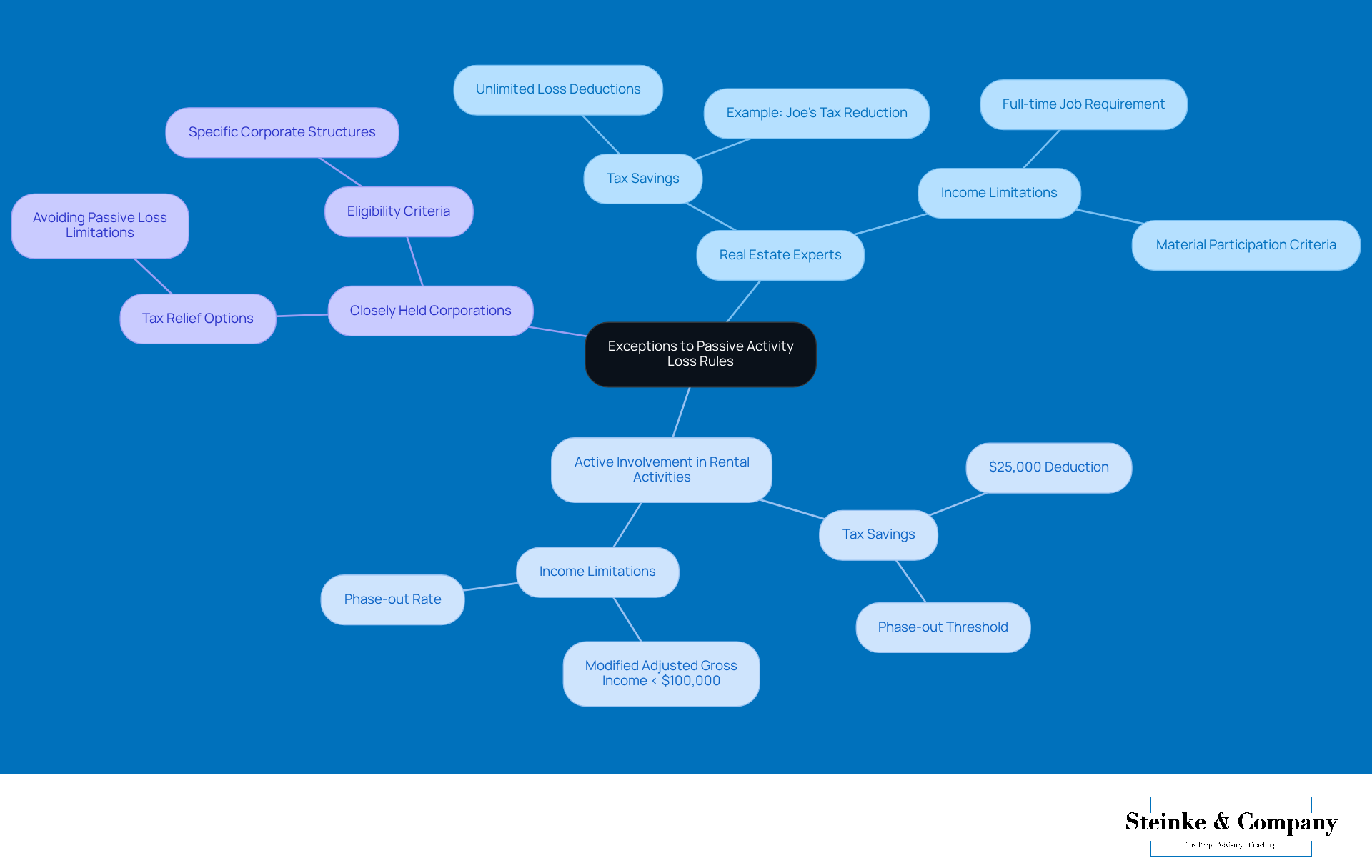
Conclusion
Mastering the nuances of Passive Activity Loss (PAL) limitations is crucial for small business owners looking to optimize their tax strategies. When you understand how PAL interacts with various income sources and deductions, you can unlock some serious financial benefits. By getting a handle on material participation and the eligibility criteria for deductions, business owners can confidently navigate the complexities of tax planning, ensuring compliance while maximizing potential savings.
In this guide, we’ve shared some key insights, like the importance of accurately calculating passive activity losses, recognizing the income thresholds that affect deductions, and exploring exceptions that might give you more flexibility in tax reporting. Real-world scenarios, such as those involving rental properties and real estate professionals, illustrate how these concepts play out in practice and highlight the potential for substantial tax relief.
Ultimately, understanding PAL limitations and their implications empowers small business owners to make informed decisions that enhance financial stability. As tax regulations evolve, staying proactive in your tax planning and leveraging available resources can truly make a difference. Embracing these strategies not only helps you manage tax liabilities but also fosters long-term growth and success in the competitive landscape of small business. So, why not take a moment to reflect on your own tax strategies? You might just find a few areas to optimize!
Frequently Asked Questions
What is Passive Activity Loss (PAL) and why is it important for small businesses?
Passive Activity Loss (PAL) refers to deficits that arise from activities where the owner has little to no involvement, such as certain investments or rental properties. Understanding PAL is crucial for small business owners as it affects their ability to offset these losses against other earnings, influencing their tax strategies and overall financial health.
How does Modified Adjusted Gross Income (MAGI) affect the ability to deduct rental losses?
If your MAGI is below $100,000, you may deduct up to $25,000 in rental losses from your other earnings. However, this deduction begins to phase out as your MAGI increases, completely disappearing once it reaches $150,000.
Can you provide an example of how a small business owner can benefit from understanding PAL?
For example, Jane, who runs a veterinary clinic and a rental business, can use a grouping election to offset losses from her rental property against the profits from her clinic, thereby lowering her overall tax bill.
What are the eligibility criteria for qualifying for deductions related to passive losses?
To qualify for deductions, small business owners must demonstrate material participation in their business activities, which can be shown by meeting any of the IRS's seven material participation tests. Additionally, the activity must be classified as non-active, such as rental activities where the owner is not actively engaged.
What income limitations affect the ability to deduct non-active income?
If your MAGI exceeds $100,000, the deduction limit for non-active income begins to decrease, disappearing entirely at a MAGI above $150,000. Active participants may deduct up to $25,000 of deficits from rental activities, but this allowance is reduced if MAGI is over $100,000.
What documentation should small business owners keep to navigate passive loss limitations effectively?
Small business owners should maintain accurate financial documentation, including paystubs and tax records, to effectively navigate their eligibility for passive loss limitations and plan their tax strategies wisely. Keeping thorough records helps with compliance and ensures that potential deductions are not missed.




